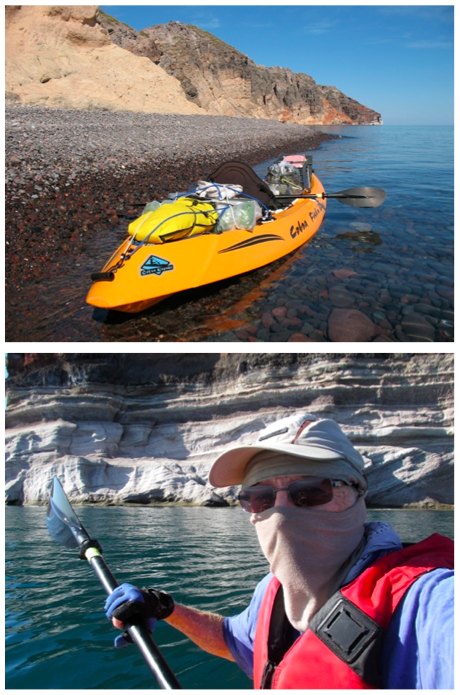San Juanico to Loreto
By Graham Mackintosh
 A week into the trip, I took my first day off in beautiful, sheltered Ensenada San Juanico. Late afternoon, a multi-million dollar powerboat, registered in the Caymen Islands, pulled in and anchored.
A week into the trip, I took my first day off in beautiful, sheltered Ensenada San Juanico. Late afternoon, a multi-million dollar powerboat, registered in the Caymen Islands, pulled in and anchored.
I paddled out and the kindly crew filled all my empty water containers with clean water. Equally important I got a reliable weather forecast. The next day would be pleasant and calm, then starting mid-morning the following day there would be strong, possibly violent, north winds! The powerboat intended to run to the shelter of the harbor at Loreto.
Back on my beach, I studied maps. I could easily wait out a north wind in San Juanico. Or I could paddle a few miles down the coast to the shelter of Punta Mangle, but I was a little concerned as my kayaking guides mentioned a hotel and development in the bay. I was not sure what I’d find but I thought it wise to get a little closer to Loreto while I could. If camping was not an option at Punta Mangle, there was another less protected beach a little further south or I could even run to the beach at San Bruno.
First light Friday I paddled out of San Juanico, passing the dramatic line of rocks at Punta Mercenarios. It was calm, exactly as forecast, and kayaking was a great way to see and photograph a beautiful colorful coast. It was hard to believe a big storm was coming.
I noted that there were few camping options beneath the cliffs. Most beaches were poor and narrow, often with rock fall danger above.
It was still calm and warm as I paddled around the point at Punta Mangle, which seemed to offer good north wind protection, and I was glad to see that all the buildings were abandoned. I walked around and explored. There was a largely disused road coming in along the shore from the direction of San Bruno and Loreto. But I was fairly confident there was no one around. It was a ghost resort. White columns stood like Greek or Roman temples on the Aegean. Storms and hurricanes had dumped enough driftwood on the beaches to finish five resorts.
There was all day shade at the northwest end where I camped right on the beach. Judging by the carcasses, fishermen obviously visited and cleaned their catch in the shelter of the bay. There was evidence of recent fish camp use, and why not. From my point of view it was just perfect and gorgeous. A few vultures waited patiently on the rocks that were full of shells and fossils.
I made camp, unloaded the kayak, and assessed my fruit and vegetable position. The only survivors from what I carried from Bahía Concepción were a still-fine looking cabbage—I’d been eating two or three leaves a day—and the inevitable couple of limes.
I slept soundly, alone beneath the stars. Next morning a fishing boat that had been out all night came ashore to clean its catch—further along the beach than before, no doubt as a concession to my presence. They were friendly folks. While two fishermen dealt with the catch—mostly pargo, sea bass, and manta rays—another boiled water for their morning coffee. I gave them a pack of Graham Crackers. And they were soon gone… in a hurry to get to Loreto. They also warned me of strong winds coming in just an hour or two.
I moved the tent up the beach and moved the kayak beside it. Then I boiled my own water for coffee. As the wind increased I found Punta Mangle very well protected. The bay was relatively flat, while the seas outside were white and churning.
I followed the road a mile out from the beach. It seemed more used by horses and coyotes than vehicles. The ruins were intriguing. Punta Mangle looked like not just a failed or unfinished resort, but the walls and staircases were maybe deliberately destroyed? With a nearby mangrove swamp the location might be buggy, but at first glance Punta Mangle deserves a resort. I loved the place and was glad to explore it Saturday and Sunday while the winds blew themselves out.
By Monday I was ready to go. I did most of my packing the previous evening, dragged the kayak back to the water. I was awake early, got the tent down and left in the dark.
There were big waves. I was concerned that if the north wind added to the seas, conditions would quickly become difficult. I paddled down to San Bruno where there is a relatively protected beach to land on. There were boats, palapas, etc. but there was no one around. Was another storm coming? I paddled out and looked ahead to miles of tough cliffs with few landing possibilities. I decided to go for it. Then, as the wind picked up, thought better of it and retreated to the sandy beach at San Bruno. After half an hour of dithering, emboldened by the sun, I finally gambled and went for it. It was just too early to camp.
There was enough of a north wind that at least my paddle past the cliffs went fairly quickly. It was a long run down the coast to Punta Bajo, to where a road runs past dozens of houses and developments to Loreto. It was generally a low rocky coast; numerous signs told of private land just in from the shore. There seemed to be no beaches or inviting places to land or camp.

I had tried to run to Isla Coronado to camp on sand. I attempted to kayak at it from the north but the shallow channel over had big waves and what looked like dangerous breaking surf. Reluctantly, I gave up on that idea as too hazardous, but approaching from the south using the island as protection seemed like a better plan, especially as that seemed to be the way the taxi boats from Loreto were reaching the island.
The distance wasn’t great, just a mile or two, but I was now battling a headwind. It was hard work, taking over two hours to reach the beautiful island. I was glad to round the southern tip and dodge the breakers to finally reach the main beach where the tourist boats anchored. A friendly Mexican was about to leave with his family. He gave me a liter of water and invited me to grab a palapa and enjoy its shade. The last boat took everyone off the island and I was camped alone.
I had shade and tables and benches, and a beautiful beach. There were no coyotes to bother me, just a few bold and ultra-friendly gulls that actually were happy to get inside my kayak and see what I’d brought them. And they soon disappeared. I felt like I was in paradise.
Next morning the boats and the tourists came. Soon there were maybe fifty folks there with me. Most seemed to be wearing wristbands and had purchased a $3 US day-pass back in Loreto. I had an annual pasaporte permit bought for the San Pedro Martir for 333 pesos or about $17-18 US.
It was good to swap stories. I invited some of the island visitors to use my shade and facilities while I explored. There were great hiking trails over much of the island, wooden signs identified many of the desert plants for you. I enjoyed my first cold beer for nearly two weeks and it was heavenly. I hadn’t had a drink for days. I was in great shape and a few pounds lighter.
The wind blew strong from the north. But the landing beach was relatively sheltered. Again by 4pm everyone was gone and I had the island to myself.
It was so wonderful to be there and I was very tempted to stay, but the real world beckoned. I readied the kayak for an early departure next morning. The wind was forecast to be less. The problem would be the residual seas coming from the north. The plan was to kayak off the island to Loreto, more or less back the way I came, using Isla Coronado as protection.
First I angled over to the Baja coast, then headed south past a series of points into the shelter of Loreto Bay before I felt able to get off the kayak and stretch my legs and call Mike Younghusband to let him know I was on my way.
Then all that remained was to paddle to town. After four hours of paddling I pulled up on the beach north of the harbor and was greeted by Mike and his very senior little dogs Max and Rusty.
It was a fitting end to be greeted by someone who walked a burro and a dog from the border to Cabo San Lucas. I enjoyed another cold beer… the first of many to celebrate safely completing the stage: Bahia Concepción to Loreto.
Now for Loreto to La Paz.
Don’t miss part 1 of Graham’s kayaking Bahía Concepción to Loreto trip!
